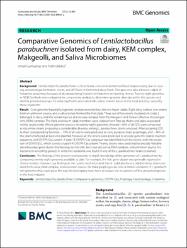| dc.contributor.author | Gumustop, Ismail | |
| dc.contributor.author | Ortakci, Fatih | |
| dc.date.accessioned | 2023-03-09T07:16:55Z | |
| dc.date.available | 2023-03-09T07:16:55Z | |
| dc.date.issued | 2022 | en_US |
| dc.identifier.issn | 1471-2164 | |
| dc.identifier.other | WOS:000894388000002 | |
| dc.identifier.uri | https://doi.org/10.1186/s12864-022-09053-y | |
| dc.identifier.uri | https://hdl.handle.net/20.500.12573/1504 | |
| dc.description.abstract | Background: Lentilactobacillus parabuchneri is of particular concern in fermented food bioprocessing due to causing unwanted gas formation, cracks, and off-flavor in fermented dairy foods. This species is also a known culprit of histamine poisonings because of decarboxylating histidine to histamine in ripening cheese. Twenty-eight genomes in NCBI GenBank were evaluated via comparative analysis to determine genomic diversity within this species and identify potential avenues for reducing health associated risks and economic losses in the food industry caused by these organisms.
Result: Core genome-based phylogenetic analysis revealed four distinct major clades. Eight dairy isolates, two strains from an unknown source, and a saliva isolate formed the first clade. Three out of five strains clustered on clade 2 belonged to dairy, and the remaining two strains were isolated from the makgeolli and Korean effective microorganisms (KEM) complex. The third and fourth clade members were isolated from Tete de Moine and dairy-associated niches, respectively. Whole genome analysis on twenty-eight genomes showed similar to 40% of all CDS were conserved across entire strains proposing a considerable diversity among L. parabuchneri strains analyzed. After assigning CDS to their corresponding function, similar to 79% of all strains were predicted to carry putative intact prophages, and similar to 43% of the strains harbored at least one plasmid; however, all the strains were predicted to encode genomic island, insertion sequence, and CRISPR-Cas system. A type I-E CRISPR-Cas subgroup was identified in all the strains, with the exception of DSM15352, which carried a type II-A CRISPR-Cas system. Twenty strains were predicted to encode histidine decarboxylase gene cluster that belongs to not only dairy but also saliva, KEM complex, and unknown source. No bacteriocin-encoding gene(s) or antibiotic resistome was found in any of the L. parabuchneri strains screened.
Conclusion: The findings of the present work provide in-depth knowledge of the genomics of L. parabuchneri by comparing twenty-eight genomes available to date. For example, the hdc gene cluster was generally reported in cheese isolates; however, our findings in the current work indicated that it could also be encoded in those strains isolated from saliva, KEM complex, and unknown source. We think prophages are critical mobile elements of L. parabuchneri genomes that could pave the way for developing novel tools to reduce the occurrence of this unwanted species in the food industry. | en_US |
| dc.language.iso | eng | en_US |
| dc.publisher | BMC | en_US |
| dc.relation.isversionof | 10.1186/s12864-022-09053-y | en_US |
| dc.rights | info:eu-repo/semantics/openAccess | en_US |
| dc.subject | Lentilactobacillus parabuchneri | en_US |
| dc.subject | Comparative genomics | en_US |
| dc.subject | CRISPR-Cas | en_US |
| dc.subject | Prophage | en_US |
| dc.subject | Food spoilage | en_US |
| dc.subject | Histamine | en_US |
| dc.title | Comparative Genomics of Lentilactobacillus parabuchneri isolated from dairy, KEM complex, Makgeolli, and Saliva Microbiomes | en_US |
| dc.type | article | en_US |
| dc.contributor.department | AGÜ, Yaşam ve Doğa Bilimleri Fakültesi, Biyomühendislik Bölümü | en_US |
| dc.contributor.institutionauthor | Ortakçı, Fatih | |
| dc.contributor.institutionauthor | Gümüştop, İsmail | |
| dc.identifier.volume | 23 | en_US |
| dc.identifier.issue | 1 | en_US |
| dc.identifier.startpage | 1 | en_US |
| dc.identifier.endpage | 16 | en_US |
| dc.relation.journal | BMC Genomics | en_US |
| dc.relation.publicationcategory | Makale - Uluslararası Hakemli Dergi - Kurum Öğretim Elemanı | en_US |


















